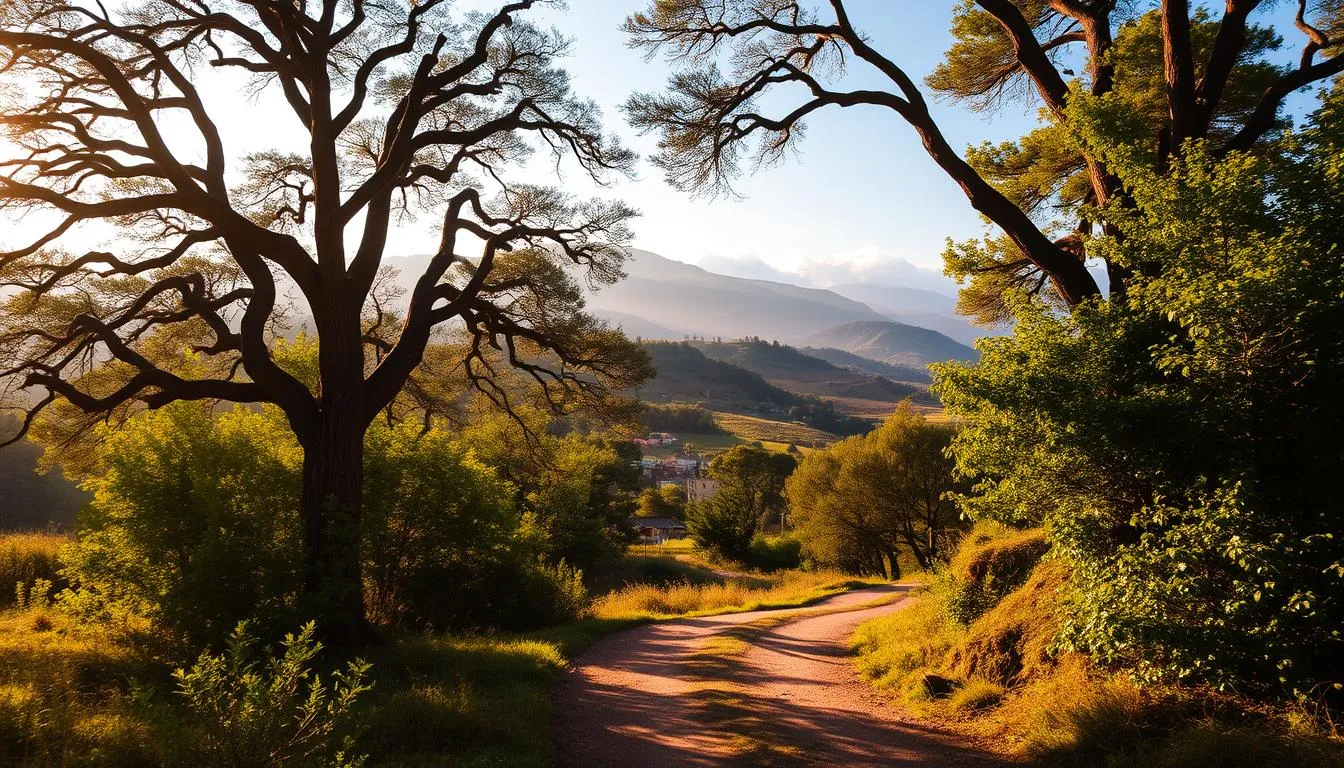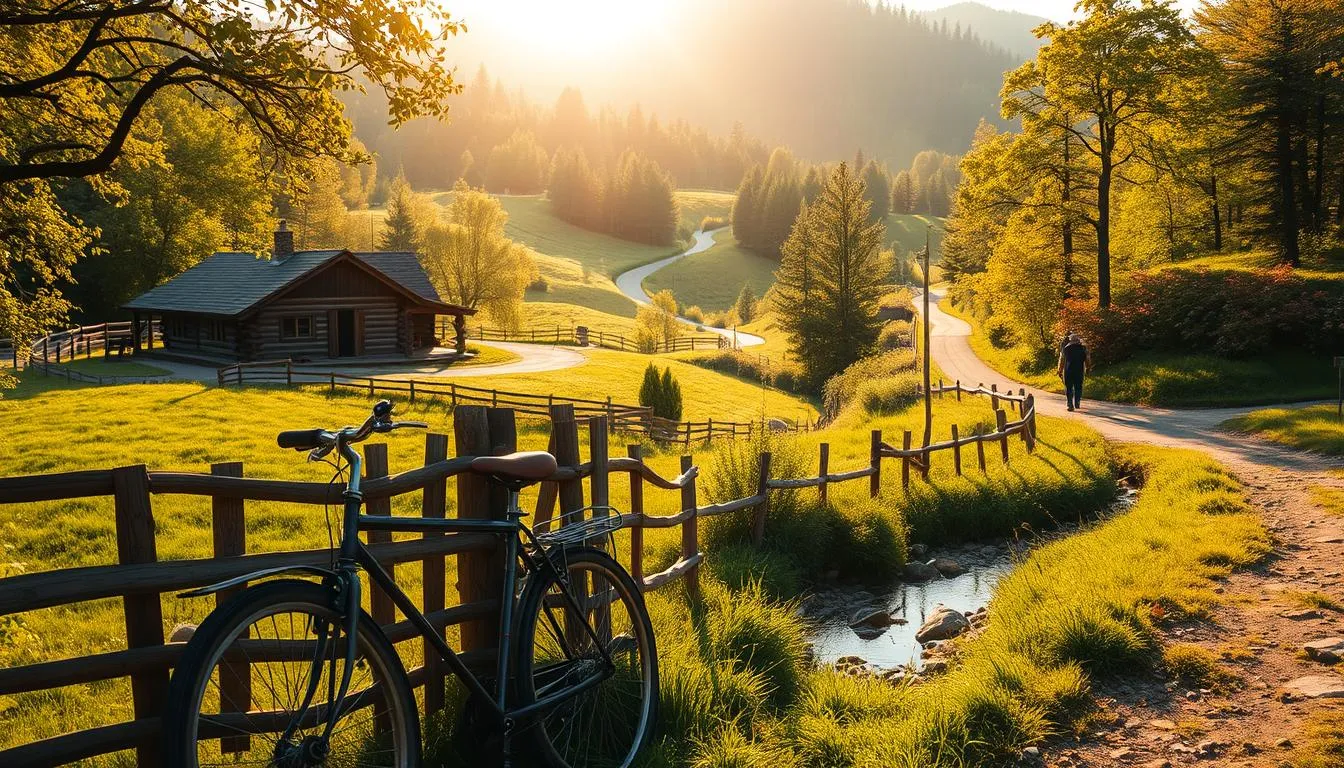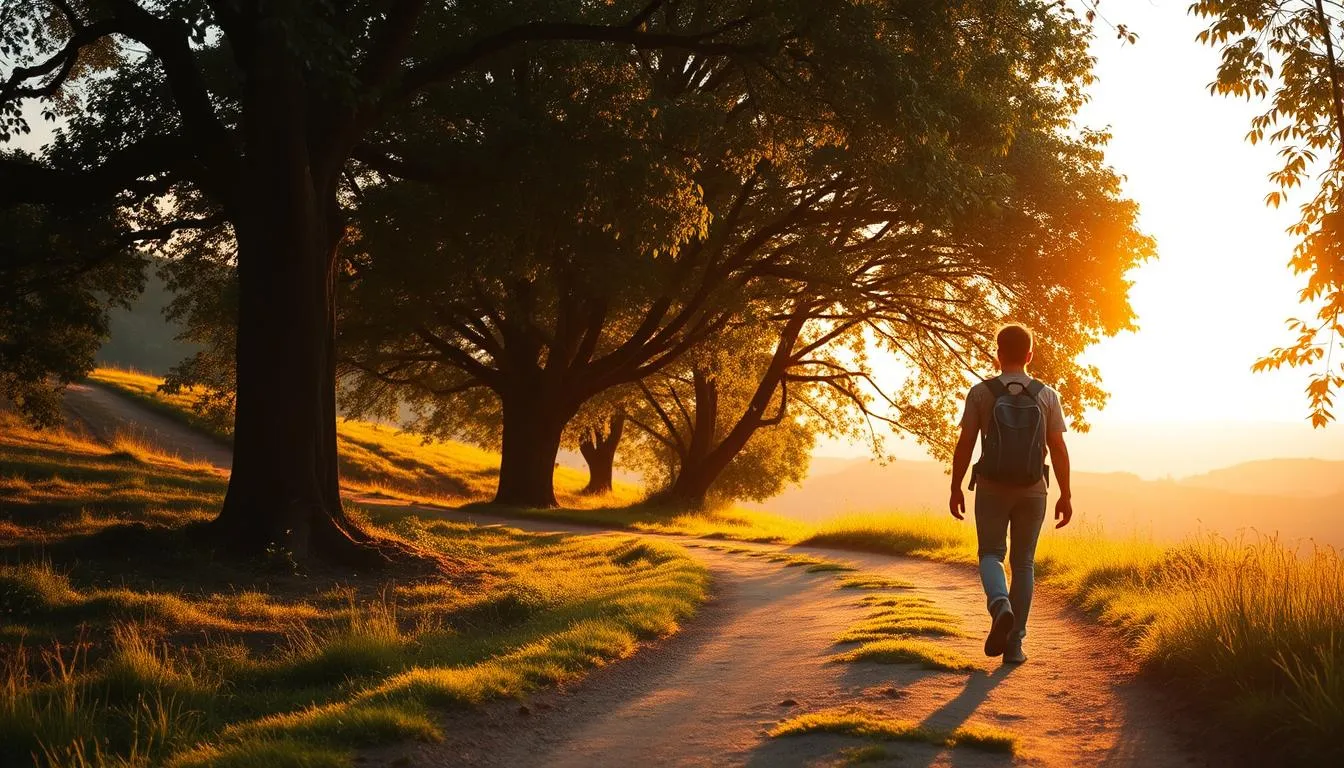Did you know that travelers who pause to spend extra time in one place report far deeper connections and greater satisfaction than those who rush through multiple sites?
This guide introduces mindful exploration techniques as a friendly, practical way to plan trips that favor presence over a packed checklist. It blends sustainability, mindfulness, and responsible tourism so you can notice local culture, food, and everyday life.
You’ll learn what slow travel means today, how it differs from fast tourism, and simple steps to apply it on short breaks or longer stays. Expect planning tips like choosing fewer destinations, adding time buffers, and picking lower-impact ways to move between places.
Slow travel is both an outer approach—how you move and where you stay—and an inner mindset about how you spend your time. If you want fresh ways to make experiences meaningful, this guide will give practical ideas you can use right away, including links to deeper resources like the guide to slow travel.
Key Takeaways
- Prioritize presence to create more meaningful experiences on each trip.
- Choose fewer destinations and add time to savor the local pace.
- Use lower-impact transport and support local businesses for sustainability.
- Balance outer choices (routes, stays) with an inner mindset of attention.
- Apply slow methods on short vacations or longer journeys for better returns.
What Slow Travel Means Today and Why It Matters
When you give yourself more time in one place, the trip itself becomes part of the story. That shift in mindset values time and attention, so the journey and the destination both add to your experience instead of just checking boxes.
“For most of human history, there was ‘no other way but ‘slow travel,’”
—Paul Salopek
Modern voices add nuance: train journeys restore the “in‑betweenness” of moving between places, and Indigenous guides stress that taking time to connect to land and each other is a real value, not a marketing line.
Why it matters: slowing your pace counters a rush culture. It helps you notice small details, meet people, and absorb local culture without burning out.
- Choose fewer stops, add buffers, or leave room for curiosity.
- Give yourself time to follow a café tip, a market, or a scenic detour.
- Doing less isn’t the point—doing the right things with intention is.
For practical ideas and deeper context, see this overview on what slow travel means.
Slow travel: roots, mindset, and how it’s different from fast tourism
What began as a protest about meals in 1986 now shapes how people choose to move through the world. Carlo Petrini’s action in Rome launched a wider call to savor quality and tradition. That idea grew into a broader cultural reply to speed and convenience.
From slow food to a movement
The Slow Food origin champions taking time for craft and taste. Scholars like Janet Dickinson and Les Lumsdown (2010) translate that ethos into practice: choose overland ways of moving, stay longer, and visit fewer destinations.
A mindset shift—presence and the in‑betweenness
Presence means treating transit as part of the day, not dead time. Writers such as Monisha Rajesh and explorers like Paul Salopek show how trains and long walks restore awareness of changing landscapes and small, serendipitous moments.
What this is not
This approach rejects packed checklists, convenience-at-all-costs, and nonstop hopping. Instead it nudges plans toward depth: more time in one place, support for local culture, and fewer unnecessary moves across the world.

- Roots: culinary protest to mindful journeys.
- Practice: overland ways, longer stays, fewer hops.
- Mindset: notice moments and local life.
| Approach | Typical pace | Common result |
|---|---|---|
| Fast tourism | Many stops, short stays | Checklist experiences, fatigue |
| Slow travel | Fewer destinations, longer days | Deeper connections, local support |
| Hybrid | One long stay plus short hops | Balance of icons and presence |
For a useful primer on applying these ideas to your own trips, see an introduction to slow travel.
How to plan a slower trip in the United States
Make a one-week escape that favors curiosity over checklists. A short timeframe can still deliver depth if you cut excess stops and allow generous windows for discovery.
Set your pace: fewer destinations, more days per place
Trim your itinerary to two or three must-dos and add time buffers to each day. This lets you follow local tips and say yes to unexpected invitations without stress.
Choose one place to stay longer and build deeper connections
Pick one place as your home base—Santa Fe, Burlington, or Asheville are good examples—and plan day trips using public transportation where possible.

Sample one-week outline that leaves room for serendipity
Aim for at least three to four days in one place to learn a café, market, or trail. A simple week might look like: arrive and settle; explore on foot; take a bus or train nearby; keep an unplanned buffer; join a community event; spend a nature day; reflect and pack.
Pack and prep for mindful days: tech, time buffers, and simple lists
Use a short list to capture local tips you hear and slot them into open windows. Pack light: reusable bottle, tote, notebook; download offline maps and enable focus modes to protect your attention.
- Tip: Cluster activities by neighborhood if you drive to save time.
- Tip: Walk or bike short routes to see more and lower your footprint.
Traveling slowly between places: choosing lower-impact ways to move
Opting for slower routes can turn hours on the move into moments you remember. Choosing lower-impact options helps the environment and makes the journey part of the experience.

Trains and public transportation: making the journey part of the experience
Favor regional rail and intercity trains where possible so transit becomes a quiet break in your day. Monisha Rajesh and Dickinson & Lumsdown note that overland trips restore awareness of the “in‑betweenness.”
Riding trains gives you time to read, watch landscapes, or meet locals. In cities, use public transportation to cut costs and see daily life up close.
On foot or by bike: local trails, neighborhood strolls, and bikepacking
Walk short routes to notice shops, murals, and parks you’d miss from a car. Try protected lanes, greenways, or rail‑trails for scenic point‑to‑point rides.
Multi‑day bikepacking can make the route itself the main highlight of your trips.
When flying is necessary: staying longer in one destination to balance impact
If you must fly, reduce the number of legs and stay longer in each place. For an example, replace a short regional flight with an overnight train and add a day to explore.
Prioritize routes that avoid backtracking. Flexible plans welcome delays and detours that often lead to the best memories.
- Pro tip: Cluster nearby destinations to spend more time on the ground and less in transit.
- Pro tip: Weigh how your choice affects the environment and the quality of your trip.
Staying longer in one place: building connections with people and culture
Choosing a single base gives you time to notice daily patterns, favorite cafes, and the rhythms that define a neighborhood. Staying longer one week or more helps you move from sightseer to participant in local life.
Outside your comfort zone: conversations, local foods, and language moments
Step outside your comfort zone by trying a dish you haven’t seen before, joining a hands‑on workshop, or using a few local phrases. Small gestures open doors and often lead to deeper connections with people who live there.
Ways to engage respectfully with local culture and community life
Prioritize community-led experiences. Seek Indigenous‑owned or community tours, like Homalco Wildlife and Cultural Tours, and avoid attractions that exploit animals or culture.
- Make staying longer one of your defaults so you can watch markets and morning routines.
- Start friendly conversations with café owners and neighbors; ask about seasonal events and local foods.
- Follow local norms, ask before photographing people, and support artisans and farmers.
- Leave thoughtful reviews, tip fairly, and revisit favorite spots at different hours to enrich your experience.
Result: with patience and respect you build meaningful bonds to people and place that outlast any single day of travel.
Sustainable and responsible slow traveling practices
Every trip can include simple practices that cut waste, boost local economies, and protect the environment.
Lower your environmental impact: buses, carpooling, and reusable gear
Pack reusable items: bottle, utensils, and a tote. These small steps reduce single‑use waste and save money.
Choose buses or carpooling over private taxis when feasible to lower emissions and meet local people.
Support local: fair trade, ethical tours, and community-owned experiences
Buy fair trade goods and book community-run experiences. That direct support helps livelihoods and keeps money in the neighborhood.
Wildlife and nature ethics: leave no trace and avoid exploitative attractions
Follow Leave No Trace: stay on trails, pack out trash, and do not visit captive-animal shows. Choosing ethical tours protects habitats and animals.
Measure your time spent versus miles covered to guide choices
Use a simple rule: maximize time spent in a destination relative to miles covered. Fewer transfers and longer stays cut carbon and deepen learning.
| Practice | Why it helps | Quick tip |
|---|---|---|
| Reusable gear | Reduces plastic and waste | Carry a bottle and tote |
| Buses / carpooling | Lower per‑person emissions | Check local schedules |
| Community tours | Supports local economy | Book small operators |
| Time vs miles metric | Less transit, more presence | Replace short flights with a train |
Example: replace two short flights with one train and a longer stay to save money, reduce stress, and find new neighborhoods. Small responsible actions add up across the world.
Conclusion
Letting your schedule breathe can turn ordinary days away from home into meaningful memories.
Choose one place, stay longer, and let curiosity guide a few simple plans. That mindset helps you build deeper connections with people and culture instead of rushing from site to site.
Even if you have only a day or a week, prioritize quality of moments—conversations, a market stop, or a quiet walk—over counting destinations. Small, responsible choices (public transit, local shops, reusable gear) make those moments better for the environment and the community.
Give yourself permission to step outside comfort and revisit favorites. When you’re open to staying longer or traveling slowly between places, the in‑betweenness becomes an opportunity for learning and joy.
For more practical tips on how this approach changes trips and supports local life, see what slow travel is and why it.
FAQ
What does mindful travel mean and why choose it?
Mindful travel means moving at an unhurried pace to notice people, places, and daily rhythms. It turns short visits into richer experiences by prioritizing connection over checklist ticking. You’ll leave with deeper memories, calmer days, and often a smaller environmental footprint.
How is this approach different from typical tourism?
Typical tourism focuses on seeing as many highlights as possible. This approach encourages staying longer in fewer places, building relationships with locals, and valuing time over milestones. Instead of rushing from site to site, you weave everyday life, markets, and conversations into your trip.
How do I plan a week-long trip with a relaxed pace?
Pick one town or small region and book a base for the full week. Divide days into a mix of guided experiences, unplanned wandering, and quiet mornings. Leave room for serendipity—an extra afternoon for a local festival or a coffee shop conversation often becomes the trip’s highlight.
Is public transportation practical for cross-country travel in the United States?
Yes. Trains, intercity buses, and regional transit can make the journey part of the experience. Amtrak routes and Greyhound or regional bus lines connect many destinations, allowing you to see landscapes, meet locals, and reduce emissions compared with frequent flights.
What’s the best way to get around within a town?
Walk or bike whenever possible. Neighborhood strolls and local bike routes reveal hidden shops, parks, and daily life in ways a car can’t. Many U.S. cities now offer bike-share systems and improved trails that make slow movement easy and enjoyable.
When is flying acceptable if I want to reduce impact?
Fly when necessary for long distances, but stay longer at your destination to balance the environmental cost. Combine your trip with nearby rail or bus excursions and choose non-stop flights to lower overall emissions when possible.
How can I build real connections with residents?
Be curious and respectful. Learn a few local phrases, visit markets, attend community events, and choose homestays or locally run guesthouses. Volunteer exchanges or workshops—cooking classes, craft sessions—offer structured ways to meet people and learn traditions.
What are simple ways to be respectful of local culture?
Observe local customs, ask for permission before photographing people, and buy from community businesses. Dress appropriately for religious or cultural sites and accept invitations with openness. Small gestures of respect go a long way in creating mutual trust.
How can I keep my visit environmentally responsible?
Pack reusable items—water bottle, bags, utensils—and choose low-impact transport like buses or trains. Support eco-conscious accommodations, avoid single-use plastics, and stick to marked trails in natural areas. These choices protect landscapes and wildlife for future visitors.
What should I do to avoid exploitative animal attractions?
Research before you go: avoid shows, rides, or interactions that stress animals. Opt for wildlife viewing guided by reputable organizations that prioritize conservation. National park programs and certified eco-tours usually follow ethical standards.
How do I step outside my comfort zone while still feeling safe?
Start small: try one unfamiliar dish, strike up a conversation in a café, or join a group class. Keep emergency contacts and local information handy, and use trusted platforms for activities and stays. Gentle challenges often lead to meaningful discoveries.
Can this way of traveling fit into a busy life or only for long sabbaticals?
It’s flexible. Even a three- or four-day getaway framed around one neighborhood or town can offer depth. Over time, frequent short stays in nearby regions build a pattern of mindful exploration without requiring months away.
How do I measure the success of a trip focused on depth rather than checklists?
Measure by moments remembered: new friendships, slow meals, unexpected detours, and a clearer sense of place. Success looks like curiosity satisfied, quieter days, and choices that leave a positive mark on hosts and landscapes.
Any packing tips for staying longer in one place?
Pack light and versatile clothing, a reliable water bottle, reusable shopping bag, and a compact first-aid kit. Bring chargers and a small notebook to record impressions. Fewer items make daily life simpler and encourage living like a local.
How can I support local economies ethically?
Spend at farmers’ markets, family-run cafés, and independent craftspeople. Book tours with local operators and choose accommodations owned by residents. Ask about fair wages and community benefits when possible to ensure your money reaches local hands.
Where can I find reputable resources and ethical tour providers?
Look to organizations like the National Park Service for nature programs, local chambers of commerce for trusted operators, and review platforms that highlight community-run businesses. Travel guides from National Geographic or Lonely Planet often list vetted, sustainable options.
